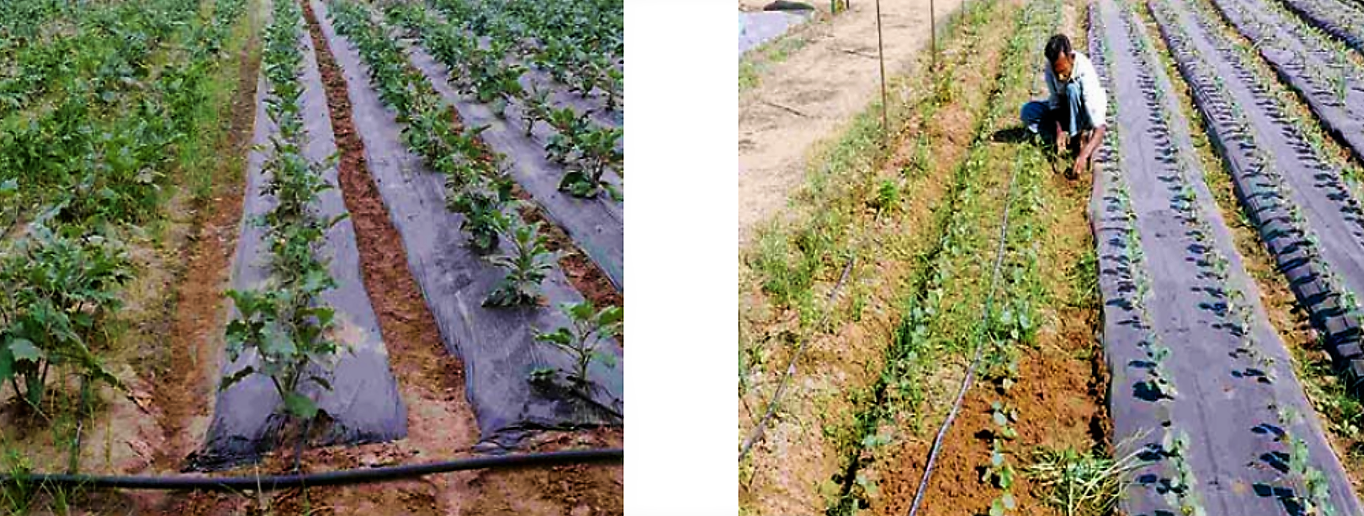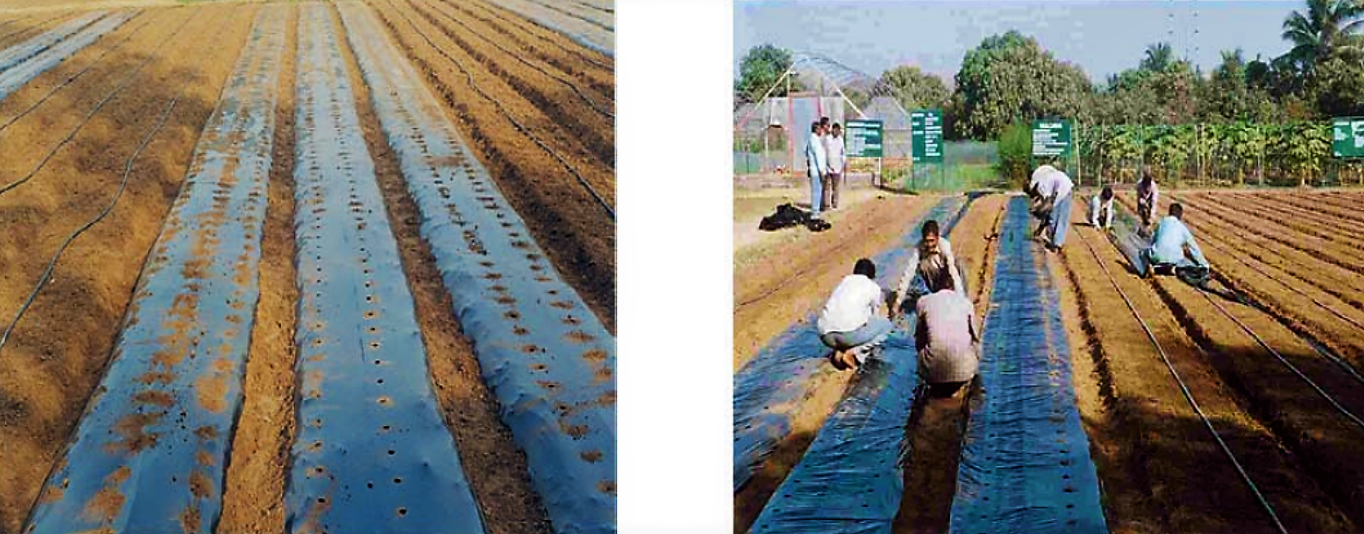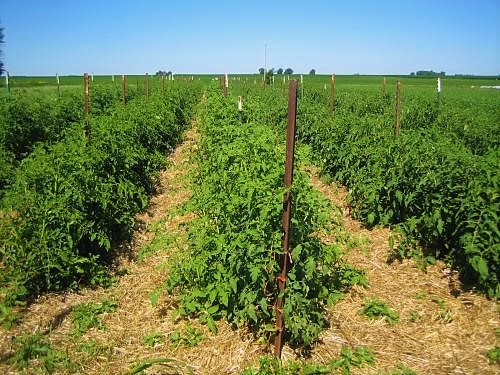Executive Summary
Mulch is a material placed on the soil surface to maintain moisture, reduce weed growth, mitigate soil erosion and improve soil conditions. Mulching (installing mulches) can help to improve crop yield and optimise water use. Mulch can be expensive however and labour intensive to obtain, transport and disperse. Materials for mulching can be organic (straw, shredded bark, wood chips) or inorganic (plastic sheeting, volcanic rock). It depends on the ecological situation of the site which mulch type should be used. Especially plastic mulch might be more expensive, not always available, and difficult to remove properly causing environmental problems. If the mulching is not installed correctly, it can have negative effects on plants and soil.
Introduction
For arable soils, the most effective conservation practices for reducing water loss through surface evaporation are those that provide some degree of surface cover for the soil. A cover can be best provided by mulches or by tillage practices that leave plant residues on the soil surface (JAMIESON et al. 2001). Mulch is any material placed on a soil surface for the purpose of reducing evaporation, retaining moisture, reducing soil erosion, suppressing weed growth and providing plant nutrients as the material decomposes (INFONET BIOVISION). Mulches act as barriers to movement of moisture out of the soil. They can be either organic (e.g. straw, wood chips, peat) or man-made (e.g. transparent or opaque plastic). Besides keeping the moisture in the soil, mulches can also enhance soil temperature; reduce the spread of soil borne diseases; reduce weed growth; reduce soil erosion (see also soil degradation); and provide nutrients and organic matter ( see also soil amendment and soil cover and reforestation). Moreover, mulches support infiltration of runoff and irrigation water as the mulches protect the soil surface from the impact of raindrops preventing soil crusting (JAMIESON et al. 2001).
Inorganic Mulches
Plastic mulches are completely impermeable; they therefore prevent direct soil evaporation and limit water losses and erosion via the soil surface. The prevented evaporation also has a supplementary effect; it avoids the rise of water containing salt, which is important in countries with high salt content water resources. Furthermore, mulches can provide a barrier to soil pathogens and especially opaque plastic mulches prevent germination of annual weeds from receiving light. They also help to maintain warm temperatures at night, which enable seeds to germinate quickly and for young plants to rapidly establish a strong root growth system (TNAU n.y.). Inorganic mulches are often applied by machinery and holes or slits allow plants to grow through. These mulches are commonly used for vegetable and small fruit crops (JAMIESON et al. 2001).

Besides plastic sheets, inorganic mulches include stone, shredded rubber, crushed glass, and geotextile. Some stone mulches include crushed gravel and granite mulches, river rock or small stone mulches, lava rock mulch, decorative and colourful stone mulch, sand mulch, and crushed brick mulch (MULCH EXPERTS 2010). Geotextile used for mulching is an expensive blanket-like synthetic fibre. This mulch allows for great water penetration. It is almost always used in combination with bark mulch and wood chips used to cover the geotextile mulch. While the geotextile mulch does not need to be replaced as frequently as the wood chips, the mulch should still be replaced at some time. A single layer of the geotextile mulch should be used. In order for the mulch to effectively let irrigation and runoff water pass through, it should be properly penetrated (MULCH EXPERTS 2010).
Organic Mulches
Typical materials for organic mulching are straw, leaves, cut grass, wood chips, peat, cut branches or the left over of old harvested crops and various types of compost (see also large and small scale composting). Since organic mulches are derived from plant material, decomposition does occur, and several undesired effects on the soil and on plant growth will be apparent to gardeners. The addition of organic mulches such as leaves or shredded bark brings almost an immediate positive effect. These effects are physical (infiltration, improved water-holding capacity, soil structure and if decomposing organic material is correctly incorporated into the soil it also has a positive effect on aeration), chemical (soil pH, release of small amounts of nutrients, decomposing) and biological (temperature regulation for increasing microorganism activity). However, if organic mulches are kept to wet disease-causing pests fungi and other undesired microorganism may develop (WILLIAMS n.y.).
Cost Considerations
Proper mulching can reduce the water needs because of reduced evaporation and enhanced water holding capacity of the soil. In general, plastic mulch is more expensive than organic mulch. It must be fabricated and disposed of. It might not be available in some countries. Organic material is almost available everywhere. It can be collected by the farmers (e.g. straw, leaves, cut grass) and does not necessarily need to be bought.
Operation and Maintenance
Inorganic Mulches

To apply plastic mulching, a lot of knowhow is required. It depends on the crop, climate, soil, precipitation, and water quality what kind of plastic mulch is used. The colour influences temperature of the soil and airflow around the plants. Deteriorated plastic mulch might be difficult to remove if it has fallen apart in little pieces and is mixed with the soil. In case the mulch film needs to be used for more than one season (thicker film) the plant is cut at its base near the film and the film is removed and reused (for more detailed information please check TNAU n.y.). In the table below, find some general instructions for selecting the correct plastic mulch (TNAU n.y.):
| Rainy season | Perforated mulch |
| Orchard and plantation | Thicker mulch |
| Soil solarisation (see ELMORE et al. 1997) | Thin transparent film |
| Weed control through solarisation | Transparent film |
| Weed control in cropped land | Black film |
| Sandy soil | Black film |
| Saline water use | Black film |
| Summer cropped land | White film |
| Insect repellent | Silver colour film |
| Early germination | Thinner film |
The selection of mulches depends on the ecological situation. Source: TNAU (n.y.)
A common practice to irrigate plastic mulched fields is the drip irrigation system where the laterals are laid under the mulch. With this technique the water can be distributed without moving the plastic mulch. Furthermore there is no evaporation or water loss.
Organic Mulches
Organic mulching has to be carried out carefully as well. The organic mulching material should be applied around established plants in the garden in mid-spring, when the soil has warmed up sufficiently for active root growth. If the mulch is applied too early, it will keep the ground cool and root development will be delayed. With newly planted material, the mulch should be applied after the plants are set in place and watered in well. If planting is done in late summer or early fall, the mulch should be applied immediately after watering the plants so that the soil temperature will be kept warm during the cool nights. It is important for fall-planted stock to have sufficient root growth so that the plants don't heave out of the ground during the winter months because of alternate freezing and thawing. Organic mulches such as leaves, sawdust, or shredded bark should be moist when applied to the soil. Extremely dry mulches act as a blotter and remove moisture from the soil (adapted from WILLIAMS n.y.).

Constraints of Organic Mulching
As beneficial as organic mulch is, too much mulch can be harmful. A thick layer of organic mulch can be effective in suppressing weeds and reducing maintenance, but it often causes additional problems. Deep mulch can lead to excess moisture (root rot, mould fungus); it can create a habitat for rodents, which damage the plant. Furthermore, thick blankets of fine mulch may prevent penetration of water and air (TREE SPECIALISTS n.y.).
- Some organisms can proliferate too much in the moist and protected conditions of the mulch layer. Slugs and snails can multiply very quickly under a mulch layer. Ants or termites, which may cause damage to the crops also may find ideal conditions for living. When crop residues are used for mulching, in some cases there is an increased risk of sustaining pests and diseases (INFONET-BIOVISION n.y.).
- Damaging organisms such as stem borers may survive in the stalks of crops like cotton, corn or sugar cane. Plant material infected with viral or fungal diseases should not be used if there is a risk that the disease might spread to the next crop. Crop rotation is very important to overcome these problems (INFONET-BIOVISION n.y.).
- When carbon rich materials such as straw or stalks are used for mulching, nitrogen from the soil may be used by microorganisms for decomposing the material. Thus, nitrogen may be temporary not available for plant growth (risk of N-immobilisation) (INFONET-BIOVISION n.y.).
At a Glance
| Working Principle | Fields for crop production or the area around trees are covered with organic (straw, shredded bark) or inorganic (plastic sheeting, stone) mulch. This mainly avoids evaporation and soil erosion from rain. |
| Capacity/Adequacy | It can be applied in every climate and with any type of societal set-up |
| Performance | Very high if operated correctly |
| Costs | Especially the costs of inorganic mulches such as plastic or geotextiles are high. But organic mulches can be recovered from gardening waste such as shredded wood or cut grass. |
| Self-help Compatibility | High if the labourers are instructed properly. |
| O&M | It can be very labour intensive and needs instructed employees |
| Reliability | It is very reliable |
| Main strength | Keeps moisture in the soil; avoids soil erosion. |
| Main weakness | Too much mulch can create new problems such as pests (e.g. fungi), anaerobic conditions, rotting of the roots. |
Mulch can be used in fields before and after planting, as well as around young crop plants. It is especially useful for high-value vegetable crops, and for growing crops in dry areas, during dry-season cropping, and in places where the soil is easily eroded by heavy rains. Where soil erosion is a problem, slowly decomposing mulch material (low nitrogen content, high C/N-ratio) will provide a long-term protection compared to quickly decomposing material (INFONET BIOVISION 2010).
Soil Solarization: A Nonpesticidal Method for Controlling Diseases, Nematodes, and Weeds
Soil borne pests can be controlled in vegetable and fruit crops by preplant application of pesticides, including the fumigants methyl bromide, chloropicrin, and metam sodium. The use of these materials, however, is often undesirable due to their toxicity to animals and people, their residual toxicity in plants and soils, the complexity of soil treatment, and their high cost. Furthermore, restrictions on the use of soil-applied pesticides seem imminent as existing environmental legislation is implemented. As a result, there has been an increased emphasis on reduced-pesticide or non-pesticidal control methods. Soil solarisation is a non-pesticidal method of controlling soil borne pests by placing plastic sheets on moist soil during periods of high ambient temperature. The plastic sheets allow the sun's radiant energy to be trapped in the soil, heating the upper levels. Solarisation during the hot summer months can increase soil temperature to levels that kill many disease-causing organisms (pathogens), nematodes, and weed seed and seedlings. It leaves no toxic residues and can be easily used on a small or large scale. Soil solarisation also improves soil structure and increases the availability of nitrogen (N) and other essential plant nutrients.
ELMORE, C.L. STAPLETON, J.J. BELL, C.E. DEVAY, J.E. (1997): Soil Solarization: A Nonpesticidal Method for Controlling Diseases, Nematodes, and Weeds. Oakland: University of California, Division of Agriculture and Natural Resources URL [Accessed: 23.02.2012]Water for Irrigation
Infonet-biovision.org is a web-based information platform offering trainers, extension workers and farmers in East Africa a quick access to up-to-date and locally relevant information in order to optimise their livelihoods in a safe, effective, sustainable and ecologically sound way.
INFONET-BIOVISION (2010): Water for Irrigation. Zürich: Biovision URL [Accessed: 09.04.2019]Soil Moisture Conservation
A paper about soil moisture conservation in Nova Scotia.
NSCA (2001): Soil Moisture Conservation. Nova Scotia: Nova Scotia Agricultural College (NSCA) URL [Accessed: 09.01.2019]Using Inorganic Mulch For Your Landscaping
Plastic Mulching
How to choose the correct plastic sheeting and the advantages and possibilities of plastic mulch are described in this document.
TNAU (n.y): Plastic Mulching. Coimbatore: TamilNadu Agricultural University URL [Accessed: 27.09.2011]Proper Mulching Techniques
This is a short manual about mulch. It explains the benefits of proper mulching, types of mulch and the problems if they are used improperly.
ISA (2005): Proper Mulching Techniques. Champaign: International Society of Arboriculture URL [Accessed: 09.07.2019]Organic Certification and Soil Conservation Compliance
Organic Mulch
Soil Solarization: A Nonpesticidal Method for Controlling Diseases, Nematodes, and Weeds
Soil borne pests can be controlled in vegetable and fruit crops by preplant application of pesticides, including the fumigants methyl bromide, chloropicrin, and metam sodium. The use of these materials, however, is often undesirable due to their toxicity to animals and people, their residual toxicity in plants and soils, the complexity of soil treatment, and their high cost. Furthermore, restrictions on the use of soil-applied pesticides seem imminent as existing environmental legislation is implemented. As a result, there has been an increased emphasis on reduced-pesticide or non-pesticidal control methods. Soil solarisation is a non-pesticidal method of controlling soil borne pests by placing plastic sheets on moist soil during periods of high ambient temperature. The plastic sheets allow the sun's radiant energy to be trapped in the soil, heating the upper levels. Solarisation during the hot summer months can increase soil temperature to levels that kill many disease-causing organisms (pathogens), nematodes, and weed seed and seedlings. It leaves no toxic residues and can be easily used on a small or large scale. Soil solarisation also improves soil structure and increases the availability of nitrogen (N) and other essential plant nutrients.
ELMORE, C.L. STAPLETON, J.J. BELL, C.E. DEVAY, J.E. (1997): Soil Solarization: A Nonpesticidal Method for Controlling Diseases, Nematodes, and Weeds. Oakland: University of California, Division of Agriculture and Natural Resources URL [Accessed: 23.02.2012]Sustainable Agriculture Extension Manual
This manual provides an overview of selected problems and issues in sustainable agriculture in Eastern and Southern Africa, and the various attempts by individuals, communities and development organisations to overcome these problems. It provides specific examples of technologies and approaches, as well as selected cases of individual farmers' and communities' experiences.
IIRR (1998): Sustainable Agriculture Extension Manual. Nairobi: International Institute of Rural Reconstruction (IIRR) URL [Accessed: 27.09.2011]Water for Irrigation
Infonet-biovision.org is a web-based information platform offering trainers, extension workers and farmers in East Africa a quick access to up-to-date and locally relevant information in order to optimise their livelihoods in a safe, effective, sustainable and ecologically sound way.
INFONET-BIOVISION (2010): Water for Irrigation. Zürich: Biovision URL [Accessed: 09.04.2019]Proper Mulching Techniques
This is a short manual about mulch. It explains the benefits of proper mulching, types of mulch and the problems if they are used improperly.
ISA (2005): Proper Mulching Techniques. Champaign: International Society of Arboriculture URL [Accessed: 09.07.2019]Soil Moisture Conservation
A paper about soil moisture conservation in Nova Scotia.
NSCA (2001): Soil Moisture Conservation. Nova Scotia: Nova Scotia Agricultural College (NSCA) URL [Accessed: 09.01.2019]Plastic Mulching
How to choose the correct plastic sheeting and the advantages and possibilities of plastic mulch are described in this document.
TNAU (n.y): Plastic Mulching. Coimbatore: TamilNadu Agricultural University URL [Accessed: 27.09.2011]Proper Mulching Techniques
This is a short manual about mulch. It explains the benefits of proper mulching, types of mulch and the problems if they are used improperly.
ISA (2005): Proper Mulching Techniques. Champaign: International Society of Arboriculture URL [Accessed: 09.07.2019]Mulching Impact on Moisture Conservation - Soil Properties and Plant Growth
The irrigated area of Pakistan mostly falls in the arid to semi-arid climatic region. Potential evapotranspiration is considerably higher, compared to rainfall received and hence, there is need to conserve soil moisture for better crop production/tree plantation. The broad objective of the study was to evaluate the efficiency of different mulching materials on moisture conservation, soil properties and plant growth. The tested options were: no mulching; placement of rice straw; placement of polythene sheet; mechanical loosening of soil.
CHAUDHRY, M.R. ; MALIK, A.A. ; SIDHU, M. (2004): Mulching Impact on Moisture Conservation - Soil Properties and Plant Growth. In: Pakistan Journal of Water Resources: Volume 8 URL [Accessed: 09.07.2019]Organic Matter Management for Soil Conservation and Productivity Restoration in Africa: A Contribution from Francophone Research
This paper reports on soil organic matter losses by erosion and leaching, and on organic matter management in five African countries. The effects of biomass management and tillage on runoff, erosion and restoration of soil productivity were studied in sets of runoff plots. In relation to increasing population, we also questioned whether it was possible to reach sufficient yields with biomass only, or whether additional mineral fertilisers were necessary.
ROOSE, E. ; BARTHES, B. (2001): Organic Matter Management for Soil Conservation and Productivity Restoration in Africa: A Contribution from Francophone Research. In: Nutrient Cycling in Agroecosystems: , 159-170. URL [Accessed: 27.09.2011]Organic Mulch
In this online article several organic mulch materials are explained as well as its physical, chemical and biological effects.

